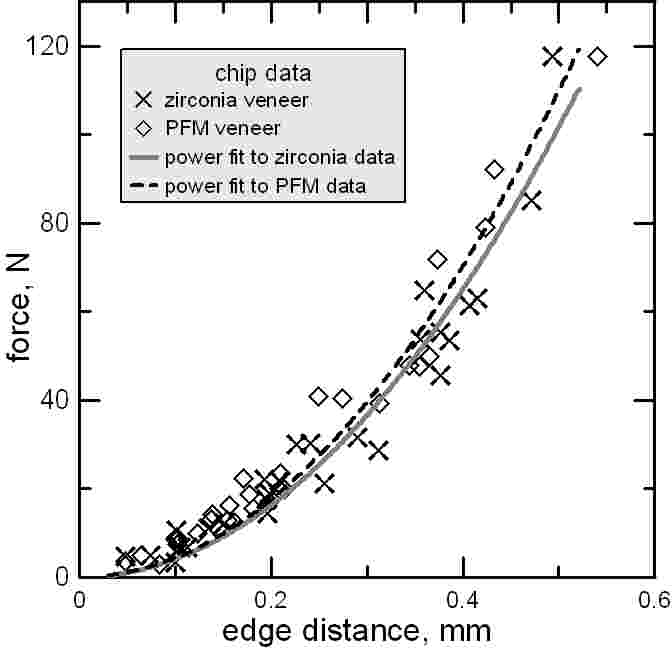 |
 |
 |
 |
Edge chipping resistance of zirconia and PFM veneering ceramics
|
J.B. QUINN1, V. SUNDAR2, and E.E. PARRY1, 1American Dental Association Foundation, Gaithersburg, MD, USA, 2Dentsply Prosthetics, York, PA, USA |  Objectives: Stabilized zirconia is becoming popular in dental restorations. It has been suggested that the susceptibility of zirconia veneering ceramics to edge chipping may be associated with undesirable clinical outcomes. In this study, the chipping resistance of a veneered zirconia combination is compared with a traditional porcelain-fused-to-metal (PFM) combination. Methods: PFM and veneered zirconia specimens were tested in a commercial edge-chipping machine. The specimens had veneer and substrate thicknesses in the clinically relevant range of about 0.8mm and 0.5mm, respectively. Forces up to 120N were applied near the specimen edges to form chips. Results: Chips readily formed in both the PFM and veneered zirconia specimens, with similar force/edge chip curves as shown. No abrupt changes in the curves are evident where the chips are large enough to go through the veneer and reach the substrate at approximately 60N. Differences in the fitted curves in this vicinity are within experimental error of the force and chip size measurements. Chips delaminated instead of continuing through the substrate interface in both types of specimens. Conclusion: The tested PFM and veneered zirconia specimens had similar resistance to edge chipping. Thus, veneered zirconia is not likely to be associated with increased chipping susceptibility in clinical outcomes. Relative resistance to delamination was not measured, but it may be a comparable problem as it occurred in both specimen types. Supported by NIST, ADAF and NIH R01-DE17983. Objectives: Stabilized zirconia is becoming popular in dental restorations. It has been suggested that the susceptibility of zirconia veneering ceramics to edge chipping may be associated with undesirable clinical outcomes. In this study, the chipping resistance of a veneered zirconia combination is compared with a traditional porcelain-fused-to-metal (PFM) combination. Methods: PFM and veneered zirconia specimens were tested in a commercial edge-chipping machine. The specimens had veneer and substrate thicknesses in the clinically relevant range of about 0.8mm and 0.5mm, respectively. Forces up to 120N were applied near the specimen edges to form chips. Results: Chips readily formed in both the PFM and veneered zirconia specimens, with similar force/edge chip curves as shown. No abrupt changes in the curves are evident where the chips are large enough to go through the veneer and reach the substrate at approximately 60N. Differences in the fitted curves in this vicinity are within experimental error of the force and chip size measurements. Chips delaminated instead of continuing through the substrate interface in both types of specimens. Conclusion: The tested PFM and veneered zirconia specimens had similar resistance to edge chipping. Thus, veneered zirconia is not likely to be associated with increased chipping susceptibility in clinical outcomes. Relative resistance to delamination was not measured, but it may be a comparable problem as it occurred in both specimen types. Supported by NIST, ADAF and NIH R01-DE17983.
|
Seq #7 - Keynote Address and Ceramics - Fractography, Fracture Mechanisms, and Residual Stress
3:15 PM-4:45 PM, Wednesday, April 2, 2008
Hilton Anatole Hotel Grand Ballroom D |
|
Back to the Dental Materials 3: Ceramic-based Materials and Cements Program
|
|
